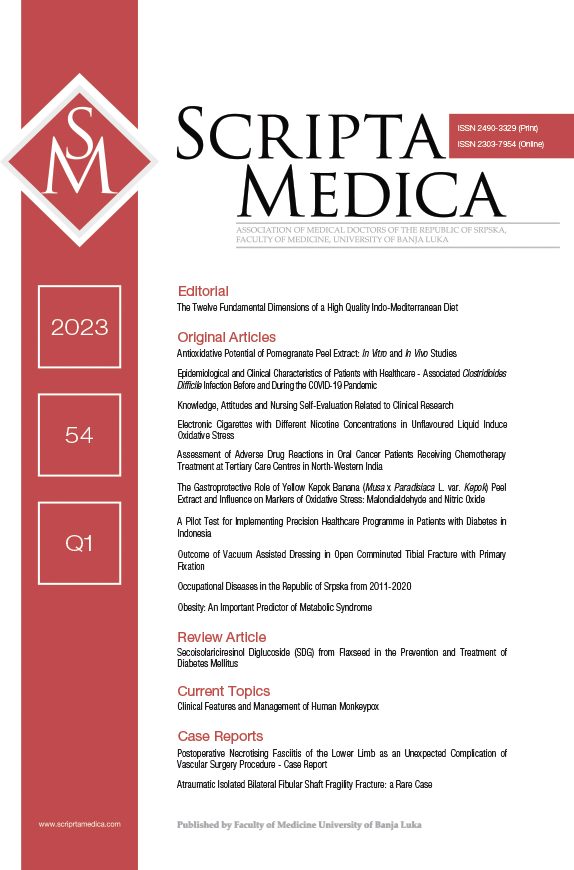Occupational diseases in the Republic of Srpska from 2011-2020
Occupational disease
Abstract
Background/Aim: The importance of occupational diseases is due to their influence on workers’ quality of life and significant socioeconomic problems for the health sector, employers and the state. Occupational diseases are generally not curable but are preventable diseases, so it is extremely important to develop a good system of detection, registration and prevention. Therefore, special attention should be paid to the occupational incidence analysis. Aim of this study was to assess the incidence of occupational diseases in the Republic of Srpska.
Methods: The research was conducted as a cross-sectional study based on the obtained data on occupational diseases in the Republic of Srpska for ten years (from 2011 to 2021).
Results: In the observed period, 12 cases of occupational diseases were registered in the Republic of Srpska and the incidence was less than 1/100,000 per year. Occupational diseases were diagnosed in: - agriculture, forestry and fishing; - construction and - healthcare and social welfare.
Conclusion: The study showed a low incidence of occupational disease and it was observed that certain industrial sectors are particularly undervalued. The current situation regarding occupational diseases in the Republic of Srpska requires an urgent response from the occupational medicine services and the state. It is necessary to initiate procedures as soon as possible to ensure uniformity in the criteria of diagnosis and records of occupational diseases and revision of the list of occupational diseases by the International Labour Organisation. In the future, it is necessary to conduct additional and more detailed research in the field of occupational diseases.
References
G
1. Graczyk H, Francois M, Krief P, Canu Guseva I. The role of the Swiss list of occupational diseases in the protection of workers’ health. Swiss Med Wkly 2021;151:w20538. doi: 10.4414/smw.2021.20538.
2. [The Law on Pension and Disability Insurance Republic of Srpska]. Sl.Glasnik RS 2022;(134/11, 82/13, 96/16, 103/15, 11/21, 15/22):1-46. [Internet]. [Cited: 30-Oct-2022]. Available at: https://www.paragraf.ba/propisi/republika-srpska/zakon-o-penzijskom-i-invalidskom-osiguranju.html. Serbian.
3. [Rulebook on the List of Occupational Diseases]. Sl.Glasnik RS 2018;(84/2018). [Internet]. [Cited: 30-Oct-2022]. Available at: https://www.paragraf.ba/propisi/republika-srpska/pravilnik-o-listi-profesionalnih-bolesti.html. Serbian.
4. Davoodi S, Haghighi KS, Kalhori SRN, Hosseini NS, Mohammadzadeh Z, Safdari R. Occupational disease registries-characteristics and experiences. Acta Inform Med 2017; 25(2):136–40.
5. Driscoll T, Leigh J, Steenland K, Nelson DI, Prüss-Üstün A, Corvalan C, et al. The global burden of selected occupational diseases and injury risks: Methodology and summary. Am J Ind Med 2005;48(6):400–18.
6. Bađun M. Costs of occupational injuries and illnesses in Croatia. Arh Hig Rada Toksikol 2017 Mar 1;68(1):66-73.
7. Driscoll T. Global and regional burden of disease and injury in 2016 arising from occupational exposures: a systematic analysis for the Global Burden of Disease Study 2016. Occup Environ Med 2020;77:133–41.
8. [Rulebook on exercising the right to salary compensation during temporary incapacity for work]. Sl. glasnik RS. 2018;(113/2018). [Internet]. [Cited: 30-Oct-2022]. Available at: https://www.paragraf.ba/propisi/republika-srpska/pravilnik-o-ostvarivanju-prava-na-naknadu-plate-za-vrijeme-privremene-nesposobnosti-za-rad.html. Serbian.
9. International Labour Organisation. ILO Convention No. 155 1981. [Internet]. [Cited: 30-Oct-2022]. Available at: https://www.ilo.org/global/standards/introduction-to-international-labour-standards/conventions-and-recommendations/lang--en/index.htm.
10. Spreeuwers D, de Boer AG, Verbeek JH, van Dijk FJ. Evaluation of occupational disease surveillance in six EU countries. Occup Med (Lond) 2010 Oct;60(7):509-16.
11. Institute of Statistics Republic of Srpska. [Statistical bulletin: Wages, employment and unemployment 2021]. [Internet]. [Cited: 30-Oct-2022]. Available at: https://rzs.rs.ba/static/uploads/bilteni/rad/BiltenStatistike_Plata_Zaposlenosti_i_Nezaposlenosti_2021_WEB.pdf. Serbian.
12. Jan J, Pavel U. Twenty-year development of occupational diseases in the Czech Republic: medical and geographical aspects. Cent Eur J Public Health 2014;22(4):251–6.
13. Szeszenia-Da̧browska N, Wilczyńska U. Occupational diseases in Poland - An overview of current trends. Int J Occup Med Environ Health 2013;26(3):457–70.
14. Gehanno JF, Postel A, Schuers M, Rollin L. Trends and topics in occupational diseases over the last 60 years from PubMed. Scand J Work Environ Health 2018;44(6):670–7.
15. Straif K. Estimating the burden of occupational cancer as a strategic step to prevention. Br J Cancer 2012;107:S1–2.
- Authors retain copyright and grant the journal right of first publication with the work simultaneously licensed under a Creative Commons Attribution License that allows others to share the work with an acknowledgement of the work's authorship and initial publication in this journal.
- Authors are able to enter into separate, additional contractual arrangements for the non-exclusive distribution of the journal's published version of the work (e.g., post it to an institutional repository or publish it in a book), with an acknowledgement of its initial publication in this journal.
- Authors are permitted and encouraged to post their work online (e.g., in institutional repositories or on their website) prior to and during the submission process, as it can lead to productive exchanges, as well as earlier and greater citation of published work (See The Effect of Open Access).

